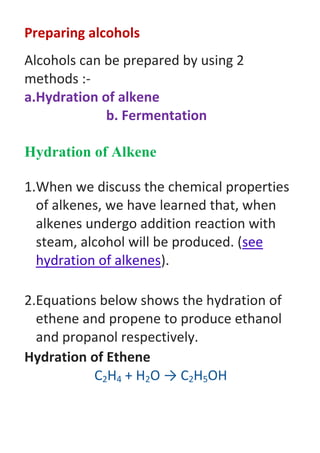
Preparing alcohols
- 1. Preparing alcohols Alcohols can be prepared by using 2 methods :- a.Hydration of alkene b. Fermentation Hydration of Alkene 1.When we discuss the chemical properties of alkenes, we have learned that, when alkenes undergo addition reaction with steam, alcohol will be produced. (see hydration of alkenes). 2.Equations below shows the hydration of ethene and propene to produce ethanol and propanol respectively. Hydration of Ethene C2H4 + H2O → C2H5OH
- 2. Hydration of Propene C3H6 + H2O → C3H7OH Fermentation 1.This method only applies to ethanol 2. Fermentation is the chemical process which microorganism such as yeastact on carbohydrate to produce ethanol and carbon dioxide. 2.When yeast is added to sugar (example: glucose), fermentation occurs. During fermentation, the yeast produce an enzyme called zymase. The zymase enzyme breaks down the glucose molecules to simpler molecule, namely ethanol and carbon dioxide. C6H12O6→2C2H5OH+2CO2
- 3. 3. Yeast is killed by ethanol concentrations in excess of about 15%, and that limits the purity of the ethanol that can be produced.
- 4. Physical properties of alcohol Boiling Points 1. The boiling point of an alcohol is always much higher than that of the alkane with the same number of carbon atoms. 2. This is because, the presence of the hydroxyl group gives extra force between the molecules, hence more heat energy is needed to overcome the intermolecular force when boiling. 3. The boiling points of the alcohols increase as the number of carbon atoms increases.
- 5. 4. This can be explained by the following: a.number of carbon increases, size of the molecule increases. b.intermolecular force increases. c.more heat energy is needed to overcome the intermolecular force. Solubility of Alcohols in Water 1. The small alcohols are completely soluble in water.
- 6. 2. However, solubility decreases as the length of the hydrocarbon chain in the alcohol increases. 3. Explanation: a. Every alcohol consists of two parts, the hydrocarbon chain which is not soluble in water, and the hydroxyl functional group, which is soluble in water. b. In short chain alcohol, the hydroxyl group plays a major part in forming forces (hydrogen bond) in between water and alcohol molecule, therefore they are soluble in water. c. For the long chain alcohol, the hydroxyl group is just a small part of the molecule. Therefore, the insoluble long hydrocarbon chain contribute more to the forces in between water
- 7. and alcohol molecule, causes the solubility CHEMICAL PROPERTIES OF ALCOHOLS COMBUSTION 1. As the hydrocarbon, alcohols undergo combustion with the presence of oxygen to produce carbon dioxide and water. 2. Combustion of alcohol producesless sootcompare to combustion of alkanes and alkenes due to the present of oxygen in the –OH group. 3.Owing to the presence of the –OH group, the percentage of carbon in alcohol is relatively low when compare with the percentages of carbon of alkanes and alkenes.
- 8. Equation: Combustion of Ethanol C2H5OH + 3O2 → 2CO2 + 3H2O Combustion of Propanol C3H7OH + 9/2 O2 → 3CO2 + 4H2O DEHYDRATION OF ALCOHOL 1.When alcohol is heated, it will decompose to form alkene and water. 2.For example, heating ethanol will produce ethene, heating propanol will produce propene, and so on. 3.This process is called dehydration of alcohol. Dehydration of Ethanol C2H5OH → C2H4 + H2O
- 9. Dehydration of Propanol C3H7OH → C3H6 + H2O Dehydration of Alcohols Using Aluminium Oxide as Catalyst Catalyst: Aluminium oxide/ Porcelain chips
- 10. Dehydration of alcohols using an acid as catalyst Catalyst: Sulphuric acid or Phosphoric acid Temperature: 170°C
- 11. OXIDATION OF ALCOHOLS Alcohols can be oxidised to produce carboxylic acidwhen react with oxidising agents. Equation: C2H5OH + 2[O] → CH3COOH + H2O
- 12. Notes: 1.The oxidising agent used: a. Acidified potassium dichromate(VI) b. Acidified potassium manganate (VII) 2.Observation: a.For acidified potassium dichromate(VI), if oxidation occurs, the orangesolution containing the dichromate(VI) ions is reduced to a green solutioncontaining chromium(III) ions. b.For acidified potassium manganate (VII), the purple colourof potassium manganate (VII) decolourised. 3.The alcohol is heated under reflux with excess oxidising agent. 4.The reflux technique used to prevent the alcohol vapour escape to the surrounding.
- 13. 5.When the reaction is complete, the carboxylic acid is distilled off. ** REACTING ALCOHOLS WITH SODIUM Revision: Reaction of Water with Sodium 2Na + 2H2O → 2NaOH + H2 1.We have learned the reaction of group 1 metals with cold water in Form 4 chapter 4, Periodic Table. 2.The reaction of alcohol with sodium is similar to this reaction. 3.If a small piece of sodium is dropped into some ethanol, it reacts steadily to give off bubbles of hydrogen gas and leaves a colourless solution of sodium ethoxide,
- 14. CH3CH2ONa. Sodium ethoxide is known as an alkoxide. 4.In the reaction, sodium reacts with the - OH group of alcohol, produces sodium alkoxide and hydrogen gas. Example: Methanol and Sodium 2CH3OH + 2Na → 2CH3ONa + H2 Ethanol and Sodium 2C2H5OH + 2Na → 2C2H5ONa + H2
